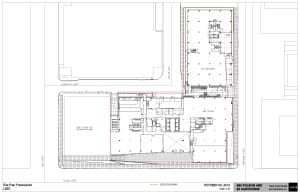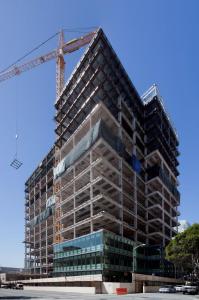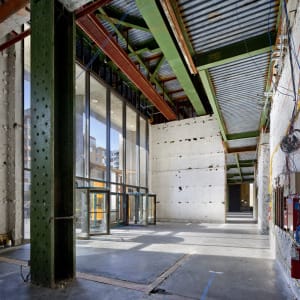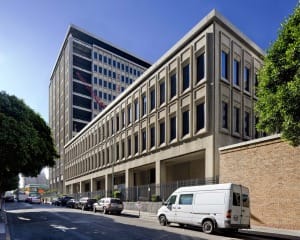News & Awards.
including honors for “Best Mixed Use,”
“Best Office,” and “Best Historic Rehabilitation”.
Old and outdated office buildings in desirable downtown locations offer interesting opportunities and options for developers in many cities, but they can present challenging construction decisions. In some situations, the buildings have been converted to residential uses. In others, they are being demolished and replaced with new buildings. Still other buildings have good structural bones but outdated systems and exteriors, and therefore offer renovation options.
When TMG Partners and Rockwood Capital acquired the outdated 680 Folsom Street along with two adjacent buildings in the heart of downtown San Francisco in 2010, all these options were possible. In the end, they chose to redesign and reshape the outdated concrete-box 680 Folsom by replacing the core and building systems, adding horizontal and vertical space, and replacing the concrete facade with a new glass facade that completely revised the structure’s image. A new concrete core was added to optimize and seismically strengthen the structure, which now exceeds seismic code requirements.
The renovated structure reads as a more complex building of varying masses with a modern look. The choice to renovate also proved to be the most sustainable approach because it reused essential elements of the building. The main tower building was leased to two principal tenants before construction began.
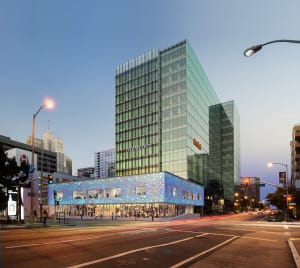
The 680 Folsom redevelopment includes three structures: an office/retail building (foreground), a 14-story renovated office tower, and a separate three-story office building (not shown) behind and to the left of the tower. (Steelblue)
The Site and the Idea
The building site is on Folsom Street between Third and Hawthorne streets in the central SoMa (South of Market Street) area of downtown San Francisco, also referred to as Multimedia Gulch. It is adjacent to the Moscone Convention Center and overlooks the Yerba Buena Gardens area that encompasses the Moscone Center. The area has emerged over the past decade as a desirable location for technology company tenants looking to move operations into the city, where many of their employees live. Since about 2004, the area has also become an increasingly popular place to live in San Francisco, especially for tech and media workers. Major tech-oriented tenants that have located or will be locating to the area include Twitter and Salesforce.
The 12-story 680 Folsom building was built in 1964 as a corporate office for Pacific Bell; by 2007, it was generally obsolete for office use and also contained a great deal of asbestos. But the large floor plates made the building attractive and interesting as a renovation project. The original facade was not attractive, consisting of heavy and outdated concrete panels with narrow windows. The site also included an adjacent three-story building with a similar dated facade, 50 Hawthorne Street, and a two-level parking structure dating from 1926 at the corner of Third and Folsom, now renovated as an office/retail building known as 690 Folsom.
The surrounding neighborhood consists of a mix of commercial and residential buildings. To the north and west are numerous restaurants, hotels, and other attractions, including the San Francisco Museum of Modern Art and the Contemporary Jewish Museum. Several mid-rise residential buildings are located on the other side of Folsom Street, and a mid-rise office building is directly across Hawthorne Street from the project. The block on which the building sits also includes a mid-rise office building, a parking structure, and a two-story brick commercial building.
The site offers easy access to transit: it is a three-minute walk to Caltrain, a commuter-rail line that connects to Silicon Valley, and a six-minute walk to the Bay Area Rapid Transit (BART)/San Francisco Municipal Transportation Agency (Muni) Montgomery Street station, which provides connections to the East Bay area as well as other areas of San Francisco. The site also offers easy automobile access to and from Interstate 80, which runs parallel to Folsom Street about two blocks to the east, allowing auto commuters to reach the building easily and avoid the more congested parts of the central city.
Development Background
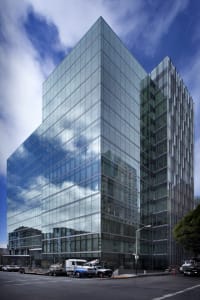
The 680 Folsom building was expanded both vertically, with the addition of two floors, and horizontally, including an extension to both the front and side of the building, highlighted in this image.
In March 2007, the site and buildings were offered for sale by Pacific Bell. TMG Partners bid on the package, but it went to another development partnership, which began a process of redeveloping the buildings. Not being selected proved fortuitous for TMG Partners because March 2007, just before the financial crisis, was not a good time to be investing in office buildings. The development partnership that purchased the buildings was unable to complete its redevelopment because of the recession, but did move the project through an entitlement process that allowed expansion of 680 Folsom by around 100,000 square feet. That entitlement was approved in spring 2008. The owner also completed some asbestos removal and abatement work on 680 Folsom, which left the interior largely gutted and with no working elevators.
Work on the building ceased, and the development partnership was unable to fund go-forward costs or pay off or refinance the loan when it matured. As a result, in May 2010 the original owner experienced a maturity default. TMG Partners, which had remained involved in the project during this time, believed the buildings offered considerable potential and pitched the opportunity to Rockwood Capital, a private equity firm it had worked with on previous deals.
Site acquisition and partnership. In October 2010, near the bottom of the market, the site and buildings were acquired by Rockwood Capital and TMG Partners in a short sale for $24 million. TMG Partners, a privately held full-service development company based in San Francisco and focused on urban infill projects in the area, has developed a mix of property types totaling 23 million square feet of office, research and development, for-sale and multifamily residential, and retail projects, plus more than 400 acres of land, with a portfolio valuation totaling $3.5 billion. Rockwood Capital is a privately held real estate investment and advisory firm that invests in various property types, concentrating on investments where it believes it can increase value through re-leasing, repositioning, rehabilitation, development, and other real estate strategies.
Development strategies. Following the acquisition, TMG and Rockwood began considering various development strategies that would create the optimal value for the site, a process that involved architects, engineers, and contractors in a value engineering process. Numerous options and factors had to be considered, especially as they related to creating a building that would meet or exceed seismic building codes in San Francisco.
Several specific programs and development strategies were considered. One was to demolish 680 Folsom and build a condominium on the site. This would have involved an extensive approval process that would have taken years to complete. The firms also looked at converting the building to residential use, but “the large floor plates were not ideal for residential,” notes Robert Gray, a partner with Rockwood Capital. Another strategy was to position the site as an expansion opportunity for the Moscone Center.
The strategy finally settled on was the office redevelopment because it offered the opportunity to create essentially a new building in a relatively short period and at an attractive cost. This strategy took advantage of the building’s considerable strengths—its large floor plates and high floor-to-floor heights—while also simplifying the approval process. Renovation was also the most sustainable approach because it reused much of the existing building. In terms of neighborhood reaction, there was little pushback regarding the renovation plans, and neighbors were supportive of the design.
The reconstruction of the building was by no means a simple process: it involved an expansion and a seismic retrofit of the building. During the decision-making process, the office leasing market in San Francisco started improving and vacancies fell, further cementing the decision to redevelop the structure as an office building. Construction began in March 2012 with 85 percent of the space preleased.
Development Finance
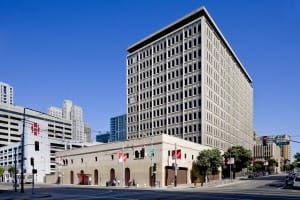
The original complex included a 1926-era two-story parking garage (foreground) and a dated and obsolete office building with a concrete facade and narrow windows.
The partnership between Rockwood and TMG involved an arrangement whereby Rockwood invested the bulk of the equity capital through one of its funds and TMG served as the operating partner for the development venture. Purchase of the site in October 2010, near the depths of the recession, was gutsy but proved to be astute. Notes Robert Gray of Rockwood, “Real estate is a cyclical industry, and we saw the deal as a good downside-cycle investment.”
As the office market in the area improved, the developer was able to arrange two major leases before construction—with Riverbed Technologies and macys.com—in January and February 2012, allowing the developers to secure construction financing that March. Heleba Bank and Nord Bank, both German entities, provided that financing at a time when it was not generally available.
Shortly thereafter, with leases and construction financing in place and a market that was improving, the owners decided to test the market for a sale in 2012—using Eastdil Secured to pitch the property to a few select buyers in an off-market sales offering—and found three interested bidders. Boston Properties, a large office REIT and one of the largest office building owners in San Francisco, acquired the asset in August 2012 for $128.5 million—while the property was under construction. Notes Robert Pester, senior vice president and regional manager with Boston Properties, “The structure offered large floor plates and the opportunity for ten-foot glass windows, which made it very attractive for tenants.”
Boston Properties funded the acquisition with a combination of cash and preferred stock; operating partnership units were also involved. The company estimates that its all-in basis for both 680 Folsom and 50 Hawthorne Street, as of fall 2014, is around $335 million, excluding interest and equity carry.
The deal was complicated because it involved numerous parties, the building was under construction, and TMG Partners was going to remain to complete the development process. Assumption of a construction loan was also required. “It was a very complicated transaction from the standpoint of multiple parties,” says Pester. “You had TMG, you had Rockwood, you had Boston Properties, you had a construction loan involved. But at the end of the day, everyone walked away from the transaction feeling very happy with the deal that they cut. It was extremely profitable for the ownership that sold it. We think we got a fantastic deal based on the timing of when we bought it.”
Notes Anthony Natsis, partner with the law firm Allen Matkins who helped negotiate the deal, “Whenever you buy something that is under construction and already preleased, you have issues. Boston Properties felt super-comfortable with TMG continuing to build it, but it was the kind of deal that got negotiated every day until it got signed and closed. It was a sign, go hard, and close deal; the principals were comfortable with each other and they knew they were going to do the deal, but there were lots of details to wrap up late in the deal process.”
In the end, Boston Properties retained TMG as the development manager for 680 Folsom and 50 Hawthorne Street through a cost-sharing agreement that provided performance incentives for TMG. Boston Properties chose to manage development of 690 Folsom itself because its construction and leasing had not begun. Boston Properties also agreed to fund the construction costs, so the construction loan was never used. Boston Properties’ cost of capital was low enough that it made sense to fund the construction without the loan. Boston Properties believed that, working with TMG, it could essentially create a new building at 680 Folsom through renovation at considerably lower cost than would be required to build a new building. The property was acquired by Boston Properties with a long-term hold strategy in mind.
Planning and Design
The designers began with the 407,168-gross-square-foot 680 Folsom office building, which had already been largely gutted. The original building had 348,388 rentable square feet of space. Among the objectives for the redesign, according to Craig Hartman, design partner with SOM, was to “find ways to lighten the building, bring in more daylight, make the building more engaging with the city, and create an urban space along Folsom.” He was also asked to add more space—both vertical and horizontal—to the building. This was possible because development rights from the adjacent two-story parking garage at 690 Folsom were transferred to 680 Folsom, allowing additional density and space to be added.
The redesign of 680 Folsom involved replacement of everything except the steel frame. “We decided that the only way we were going to be successful was to make the building a completely modern building,” notes TMG CEO Michael Covarrubius. Paradoxically, he notes, due to the large floor plates and high ceilings, “in the end, we created a building that you couldn’t build today in San Francisco.”
Building frame. Though the facade of the original building was no asset, the large floor plates and large slab-to-slab heights were very attractive and hard, if not impossible, to replicate with new construction. The building featured original floor plates of 29,825 gross square feet (27,500 rentable square feet), twice what the current code would allow. The building also had 15-foot deck-to-deck heights, with 11-foot finished ceilings that allowed for ten-and-a-half-foot floor-to-ceiling windows. These features made it clear that retaining the existing frame offered considerable advantages.
Vertical and horizontal expansion. Essential to updating the look of the building was the decision to add two floors as well as several small horizontal additions, resulting in an increase to 468,783 rentable square feet of space from 348,388 rentable square feet. The additional floors added to the profile of the building, and the building footprint along Folsom was bumped out about 24 feet near the intersection with Hawthorne, adding corners and additional space, reshaping the building from a rectangular box to a more multifaceted form. Horizontal space was also added to the building footprint along Hawthorne Street. In addition, a three-foot cantilevered wing wall was added to the back of the building, and a wing wall also was added along the building corner near Folsom and Third streets. All these additions helped the architect improve the proportions and add variety to the streetfront presentation for each of the facades.
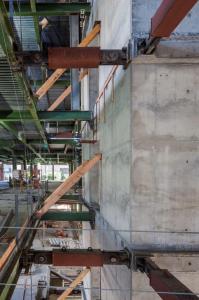
Horizontal braces link the new concrete core of 680 Folsom to the existing steel frame. The building has been seismically retrofitted to exceed building code requirements.
Glass facade. Clearly the most visible element in modernizing the building was replacement of the concrete-and-glass facade with a high-performance glass curtain wall. The new unitized glass wall provided numerous and essential improvements for the building.
It brought a fresh and modern look to the building. Also, because the glass was much lighter than the concrete, it reduced the weight of the building, allowing the addition of two stories without compromising the structural integrity of the steel frame. Plus, the high-performance glass is essential to improving the energy performance of the building, an important factor in achieving Platinum certification under the U.S. Green Building Council’s Leadership in Energy and Environmental Design (LEED) program.
The high-performance glass minimizes solar loading while maximizing visual transparency, including views from the building at night. The facade even includes bird safety features. The new envelope includes vertical aluminum fins on the northwest-facing facade to shield the glazing from the setting sun.
Seismic retrofit and core redevelopment. Earthquakes are a fact of life in San Francisco and pose a considerable threat to buildings. The original 680 Folsom was not up to current seismic code requirements and included a poorly shaped core. To meet both code and tenant requirements, a core-area and seismic retrofit was required.
The developers entered a value engineering process—with the engineers, the architect, and contractors—to determine which of many structural and core redesign options would be optimal for the building. They settled on a scheme developed by their engineering firm, Tipping Mar, that involved the addition of a new concrete core that was set on a friction-pendulum base isolation system at the basement level. This involved considerable foundation work, including driving piles 40 feet into the ground and caissons drilled into the sand below the basement.
According to architect SOM, “This seismically upgraded core uniformly engages all floors, spreading the existing steel frame’s strength evenly throughout the height of the building.” Notes Steven Tipping, founding principal of Tipping Mar, the structural engineer for the project, during an earthquake the new structural system “forces the whole building to shift rather than just the lower floors,” reducing the risk of a building collapse due to buckling of lower floors.
Tipping Mar documents describe the system in greater detail: “This new stiff core engages all floors of the existing steel moment frame, compelling all floors to lean uniformly and spreading inelastic action evenly throughout the entire steel frame. This makes a single-story collapse impossible; it also marshals and spreads the strength of the existing frame uniformly over the height of the building. The frame additionally acts as a spring that returns the building to plumb after an earthquake.
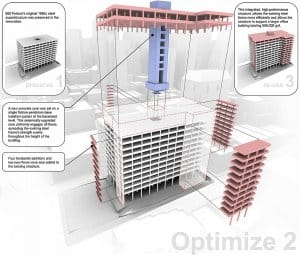
Preserve, reuse, and optimize were three key principals that guided the planning and design process. This rendering shows the structural changes implemented to modernize the building.
“In this way, a 1960s-vintage steel building has been given a seismic performance that meets or exceeds current code expectations (for instance, interstory drifts are 25 percent better than that required by current code). . . . The single core pivoting on a single bearing resulted from an intensive value engineering effort that saved $4 million compared to an earlier post-tensioned double-core scheme that also performed remarkably well.” The design was peer reviewed by the chair of Stanford University’s structural engineering department.
The building core was also reshaped. The original core was essentially a square inside a rectangular building—not an efficient use of space. The new core is more rectangular, which helped optimize the leasing depths; the core now includes six elevators, and the original two-stairwell plan was expanded to three stairwells. Restrooms were added in anticipation of the high-density occupancy expected in the building.
Building systems. All the mechanical, electrical, and plumbing systems were replaced and were designed and configured to accommodate dense occupancy—one person per 100 square feet, a very high density requiring extra investment in the electrical, plumbing, and heating, ventilation and air-conditioning systems in the building. The elevators are Mitsubishi destination dispatch elevators.
Green building features. LEED Platinum certification of 680 Folsom was based on a number of green design and construction features, according to architect SOM. They include the following:
- Energy cost savings of 25 percent through an improved thermal envelope, high-efficiency fenestration, reduced interior lighting power density, reduced exterior lighting power, demand-control ventilation, and high-efficiency chillers and boilers.
- A 41 percent reduction in potable water use from a calculated baseline design through the installation of water-conserving toilets, urinals, and lavatory faucets.
- A minimum 2 percent glazing factor in 84 percent of all regularly occupied spaces, affording direct line-of-sight views for 99 percent of all regularly occupied spaces.
- The reuse/maintenance of 75 percent of the existing structural elements.
- Seismic improvements.
- Installation of landscaping and outdoor terraces on the ground floor, on level two, and on the roof to serve the building users.
The building’s walkable location and proximity to transit were also attractive sustainability features.
Lobby and roof deck. The new lobby has 30-foot ceilings, walls of salvaged eucalyptus wood, and LED-backlit white onyx at the reception desk, over which hangs a large work of art featuring San Francisco themes. Outside the building near the entrance is a glass sculpture.
A 5,000-square-foot rooftop viewing deck provides panoramic views of San Francisco Bay, as well as the Giants baseball park; the deck has been leased exclusively to macys.com as part of its multifloor lease.
680 Folsom tenant spaces. In keeping with the tenant profile of the area, the building was designed to accommodate high-density office layouts and collaborative space plans. Some of the initial space-plan layouts included 375 workstations and 16 conference rooms on one floor. The actual tenants have chosen less-dense office layouts.
Riverbed Technology occupies floors two through seven and houses 600 employees at this headquarters location. Its space includes ample kitchen facilities, as well as game rooms with foosball, table tennis, pool tables, and pinball machines. A large arrangement of video screens takes up an entire wall of its lobby. Macys.com occupies floors eight through 14.
In addition, ground-level office space at 680 Folsom facing Hawthorne Street has been finished and is being marketed as “ready to move in” space. It features a conference area, a kitchen, 20-foot-high-plus ceilings, and an open and flexible floor plan.
There is also one retail space at the corner of Folsom and Hawthorne, occupied by a deli/sandwich shop and caterer.
50 Hawthorne Street. A small courtyard separates 680 Folsom from 50 Hawthorne Street, which runs perpendicular to 680 Folsom along Hawthorne Street. The three-story, 55,000-square-foot building has been clad in glass similar in style and color to that of the main building. Because the Hawthorne building is only three stories, a seismic retrofit was not required, but the building interior was upgraded to standards similar to those of 680 Folsom. Much of the tenant finish work is being undertaken by the new tenant, athenahealth, a cloud-based health records company.
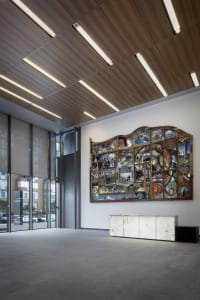
The new lobby features 30-foot ceilings, salvaged eucalyptus wood walls, and a large work of art featuring San Francisco themes.
690 Folsom. Located at the corner of Folsom and Third streets, the 25,000-square-foot 690 Folsom, will consist of first-floor retail space and second-floor office space. As of November 2014, construction of the core and shell of the building was nearing completion. The building exterior was redesigned after Boston Properties acquired the structure, and the firm is managing development of the property.
The new design, by architect Charles F. Bloszies, uses a spider web–like aluminum exterior backed with LED lighting, allowing the facade to change color, matching seasonal or other themes as desired. These features will add a dynamic and colorful quality to this prominent corner across from the Moscone Center.
Parking. The underground parking garage is reached through an alley off Third Street; loading docks are also located in this alley. Because the amount of parking in 680 Folsom exceeded code requirements, no additional parking was needed;in fact, the parking garage at 690 Folsom is being replaced with more office and retail space. The site is well served by transit and many workers in the building walk or bike to work, so the high-density occupancy of the building has not been a problem for the parking.
One thing that did need to be addressed was an inadequate supply of bike parking. Bike parking was added to the basement to meet code requirements, but this addition proved to be insufficient. Riverbed has added over 40 bike stalls in the garage at its own expense to address the issue, and bike parking has also been added to the B1 level of 50 Hawthorne Street.
Construction. The construction process itself brought some surprises. For example, asbestos was found in places that the developers did not expect, and about $2 million was spent on removal or remediation. They also changed the sequencing of the construction at 680 Folsom as the project proceeded, employing a top-down and bottom-up approach at the same time. In the end, the project was completed about $18 million under budget, in part because numerous contingencies included in the original budget to cover unforeseen problems were not needed.
Leasing and Management
One remarkable feature of the leasing process was that the building was shown and ultimately leased before it was finished. The previous developers had gutted much of the building, but the existing exterior remained and no new construction had yet begun. The leasing staff was charged with selling a vision of what would be, not what was. Notes Chris Roeder of Jones Lang LaSalle, the leasing broker for the project, “We sold the building on the fact that everything would change.” This was not easy, he notes, because “tenants often don’t know what they want until they see it.”
As noted, the building’s many positive features helped with the leasing, not the least of which were the large floor plates and high ceilings—features that could not be duplicated in competing buildings. In addition, because the entire building was available, it offered a large block of space—in fact the largest block of space on the market in downtown San Francisco at the time—making it a preferred property for larger tenants. The leasing also benefitted from a rising market tide in 2011 and 2012 and minimal new space coming online.
Office leasing. The first lease for the project was with Riverbed, which was signed in January 2012. The original lease was for 167,788 square feet for ten years. Roeder notes that Riverbed officials, being the first to commit to the project, “knew they could negotiate a good deal and keep their costs low,” and the lower-floor spaces were well suited to company needs. In March 2012, Riverbed expanded its lease by about 35,000 square feet to a total of 202,467 square feet on floors two through seven.
The macys.com lease was signed in February 2012, encompassing 242,753 square feet on the upper floors. This lease was for 15 years at slightly higher rents due in part to the views provided by the higher floors. Macys.com also obtained exclusive access to the roof deck as part of its lease.
The building was 85 percent preleased to these two credit technology tenants before the resumption of construction. Notes Sean Donnelly, director of construction management for TMG Partners, “The market came back faster than expected.” These two leases together allowed the project to proceed ahead of many others following the recession. Both of the lead tenants have their logos on the facade, with macys.com on the southwest and Riverbed on the southeast.
Space at 50 Hawthorne Street has been leased entirely to one tenant, athenahealth, which signed a 12-year lease in December 2013. The company relocated to the city from San Mateo in part to tap into the skilled labor force in the city. Two office spaces at the site are currently available for lease, one on the lower level of 680 Folsom and one on the second level of 690 Folsom.
Retail leasing. The retail space consists of 11,344 square feet at the corner of Folsom and Hawthorne, and about 12,500 square feet on the lower level of 690 Folsom. The former has been leased to Specialty’s Café & Bakery, a deli/sandwich shop and caterer; the latter is under construction and still being marketed, with restaurants as the desired tenant type.
Observations and Lessons Learned
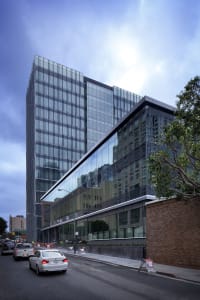
The three-building complex includes a separate three-story office building—50 Hawthorne Street—that has been leased to athenahealth.
Many investors have trouble envisioning the future during down markets. When Rockwood and TMG acquired the properties, they did not know when the market would strengthen, but they were confident that it would. For them, taking a long-term view during a troubled and uncertain time was important: vision and perseverance are critical when times are bad. This was a key factor in the project’s success.
In the evaluation of investment prospects in bad times, replacement cost is an important measure that should not be overlooked. When the developers were evaluating the investment prospects for the property in 2009 and 2010 when markets were still in turmoil, they saw the investment as “an opportunity to invest at below the replacement cost,” notes Matt Field, managing director of TMG Partners. They estimated that they could complete the project at 25 percent below replacement cost for a new building. This essentially helped reduce risk because they knew they could be competitive with any new product that might come on line in the future since that product would cost more to produce.
The value engineering process—involving engineers, architects, contractors, investors, and the developer working collaboratively—was essential to making a determination about the best course of action. This process enabled the team not only to come up with a cost-effective seismic retrofit plan, but also allowed it to technically evaluate the opportunity to expand the building vertically. The architects and engineers worked closely with the contractor regarding means, methods, and costs, which was essential in providing the cost estimates for various options. “An integrated approach to design, engineering, and construction is invaluable in renovation projects like this,” Hartman says.
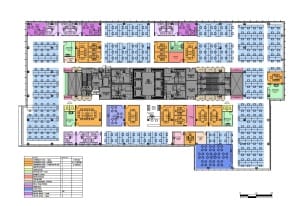
An illustrative floor plan shows the new building core and an example of how a very high-density layout could look. The current tenants have arranged their spaces at lower densities.
Older buildings often have many unknowns, and contingency budgets are required. When a complex renovation and retrofit project is being undertaken, if the construction is managed effectively, contingency budgets may come in well below budget, which goes straight to the bottom line. But accomplishing this requires an experienced development team that can work together. Notes Donnelly, “We had worked with all of the team members before.”
The economic results thus far have exceeded the pro forma estimates, including higher rents, lower costs, higher internal rate of return, and higher equity multiples than forecast. And the address 680 Folsom Street now has a new image and a new meaning for both tenants and neighbors in San Francisco.
The ability to envision a future for an obsolete building in a transitional location during a down market cycle was a key factor in the project’s success, but it also took considerable development, design, and engineering expertise to craft and execute a plan that would work to reposition and retrofit the building. The result: 680 Folsom Street now has a modern image, with green and resilient building features, and serves as an important new place in the heart of the cool San Francisco neighborhood SOMA.
Project Information
| DEVELOPMENT TIMELINE | |
| Year | |
| Initial construction | 1964 |
| Site purchased by an equity partnership | March 2007 |
| Entitled for expansion | Spring 2008 |
| Maturity default by original developer | May 2010 |
| Site acquired by TMG and Rockwood | October 2010 |
| Planning/value engineering | 2011 |
| Riverbed Technologies lease signed | January 2012 |
| macys.com lease signed | February 2012 |
| Construction started | March 2012 |
| Sold to Boston Properties | August 2012 |
| athenahealth lease signed | December 2013 |
| Phase I completed | January 2014 |
| 690 Folsom portion completed | 2014 |
| NET RENTABLE BUILDING AREA | ||
| Use | Area (sq ft) | |
| 680 Folsom office/retail | 468,783 | |
| 50 Hawthorne Street office | 52,827 | |
| 690 Folsom office/retail | 25,000 | |
| Total net rentable area | 546,610 | |
| Note: The building also has 130 underground parking spaces. | ||
| LAND USE PLAN | ||
| Site area (sq ft) | Percentage of site | |
| Buildings | 48,777 | 72.5 |
| Landscaping/open space | 18,490 | 27.5 |
| Total | 67,268 | 100 |
| * excluding 690 Folsom building | ||
| OFFICE INFORMATION | ||||
| Office/retail net rentable area* | 521,610 sq ft | |||
| Percentage of NRA occupied* | 100% | |||
| Number of tenants* | 3 | |||
| Typical tenant size* | 200,000 sq ft | |||
| Annual rent range* | $50-$70 per sq ft | |||
| Average length of lease* | 10-15 years | |||
| *excludes 690 Folsom building | ||||
| Major office tenants | NRA (sq ft) | |||
| Riverbed Technologies | 202,467 | |||
| macys.com | 242,753 | |||
| athenahealth | 52,827 | |||
| RETAIL INFORMATION | ||
| GLA (sq ft) | ||
| 680 Folsom | 11,344 | |
| 690 Folsom | 12,500 | |
| Total | 23,844 | |
| Percentage of retail GLA occupied | 48% | |
| Key retail tenants | Retail type | GLA (sq ft) |
| Specialty’s Café and Bakery | Food service | 11,344 |
| DEVELOPMENT COST INFORMATION | ||||
| Site acquisition cost | $24,500,000 | |||
| Hard costs* | $126,800,000 | |||
| Soft costs* | $15,240,000 | |||
| Other costs* | $61,200,000 | |||
| Total development cost* | $227,740,000 | |||
| * excludes 690 Folsom building | ||||
| FINANCING INFORMATION | ||||
| TMG/Rockwood acquisition cost | $24,500,000 | |||
| Boston Properties acquisition cost | $128,500,000 | |||



